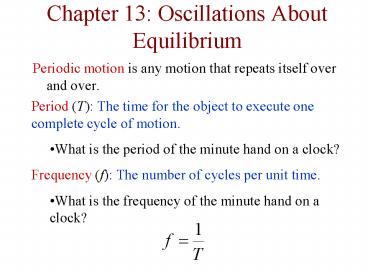Chapter 13: Oscillations About Equilibrium - PowerPoint PPT Presentation
1 / 21
Title:
Chapter 13: Oscillations About Equilibrium
Description:
28 ms of (my) clarinet tone (stereo) 15 oscillations of 543 Hz fundamental. ... When the car hits a bump in the road it oscillates up and down with a period of ... – PowerPoint PPT presentation
Number of Views:250
Avg rating:3.0/5.0
Title: Chapter 13: Oscillations About Equilibrium
1
Chapter 13 Oscillations About Equilibrium
- Periodic motion is any motion that repeats itself
over and over.
- Period (T) The time for the object to execute
one complete cycle of motion. - What is the period of the minute hand on a clock?
- Frequency (f) The number of cycles per unit
time. - What is the frequency of the minute hand on a
clock?
2
A musical tone is a periodic motion of the air
- 28 ms of (my) clarinet tone (stereo)
- 15 oscillations of 543 Hz fundamental.
3
Simple Harmonic Motion
Simple harmonic motion is one example of periodic
motion in which the displacement of the object
from its equilibrium position is sinusoidal.
Example the oscillation of a mass attached to a
spring.
F kx
The force on the mass points toward the
equilibrium position it is a restoring force.
4
Simple Harmonic Motion and Uniform Circular
Motion (radiusA)
q
y
x
- x A cosq Acos(wtq0), q(t) wtq0 ,
special case, q0 0 - y A sinq Asin(wtq0),
- Period T 2p/w speed v (2pA) / T wA
- vx v cos(qp/2) - v sinq -wA sin(wtq0),
- vy v sin(qp/2) v cosq wA cos(wtq0),
5
Acceleration in Uniform Circular motion
This acceleration formula looks just like the
spring force Spring F - k x Newtons 2nd
Law F m ax m ax - k x, ax - (k /m)
x w2 k/m
6
Acceleration in Simple Harmonic Motion
Acceleration is in opposite direction to
coordinate.
7
Simple Harmonic Motion
The amplitude (A) of the motion is the maximum
displacement from equilibrium
The position of the mass at any time t can be
calculated from
assuming that x is at its maximum positive value
at t 0.
8
Phase and Period
- x(t) Acos(wtq0)
- wtq0 phase of oscillation (not an angle of
rotation). - T Period time for one oscillation
- T 2p/w, because phase increases by 2p radians
(one oscillation) as t ? tT. - q0 0 if position x(t0) is the maximum of the
oscillation.
9
Angular Frequency
Remember (Chapter 10) that the angular velocity
was related to the period of the circular motion
In the context of simple harmonic motion, we
still use w but refer to it as angular frequency.
So now we can rewrite the formula for the
position of the mass on the spring x(t)
Acos(wt) if x(0) A
10
Walker Problem 9, pg. 411
The position of a mass oscillating on a spring is
given by x (7.8 cm)cos2pt/(0.78 s). (a) What
is the frequency of this motion? (b) When is the
mass first at the position x 7.8 cm?
a) w(2p)/(0.78 s) f 1/(0.78s) 1.28 Hz b) x
(7.8 cm)cos(wt) -7.8 cm cos(wt) -1 wt p t
p / w (0.78s)/2 0.39 s .
11
The Period of a Mass on a Spring
The angular frequency for the simple harmonic
motion of a mass on a spring is
Therefore, the period for the oscillations of a
mass on a spring is
12
Walker Problem 31, pg. 412
Two people with a combined mass of 125 kg hop
into an old car with worn out shock absorbers.
This causes the springs to compress by 8.00 cm.
When the car hits a bump in the road it
oscillates up and down with a period of 1.65 s.
Find (a) the total load supported by the springs
and (b) the mass of the car.
13
(No Transcript)
14
How is motion affected by changes in mass, spring
constant, amplitude?
15
The Pendulum
The oscillations of a pendulum (assuming small
angle oscillations) is also simple harmonic
motion.
The period of a pendulum is
T is independent of mass.
16
The Pendulum
Small angle oscillations Torque -mgLsinq ?
-mglq
- Rotational motion (chap 10)
- tIa, a angular acceleration
- (ml2)a - mglq
- - (g/l) q
- q qMax cos(wtf0)
- w2 g/l
(wtf0) phase of oscillation, NOT the angular
position q of the pendulum.
17
Kinetic Potential Energy in Simple Harmonic
Motion
A
18
Damping (optional)
- Aerodynamic friction, Magnetic damping
(Regenerative brakes on hybrid cars), - Fdamping - b v ma -mw2 x b v
- a -w2 x (b/m) v
- Underdamped b/(2m) lt w Overdamped b/(2m) gt w
- x(t) Ae-bt/(2m)cos(wtq0) x(t) Ae-gt
19
Driven Oscillations and Resonance
- To increase the amplitude of an oscillation, you
must add energy to the system. The timing is
important. If you add energy (drive) the system
at its natural (resonant) frequency, you can
dramatically increase the amplitude of the
oscillations. - Examples
- pushing a child on a swing
- Tacoma Narrows Bridge
20
Driven Oscillator
Push on a mass on a spring with a static force
F0. Equilibrium 0 -kx F0 x F0 /k
Push on a mass on a spring with oscillating
force F -F0sin(wt)
21
Quiz 8
- A mass m oscillates on a spring with Hookes law
force constant k. - The period of oscillation is T 2p/w 2p
(m/k)1/2 - By what factor does the period of oscillation
change in the following three cases - The mass is doubled
- The force constant k is doubled (with original
mass). - The amplitude of oscillation is doubled (with
original values of k and m).































